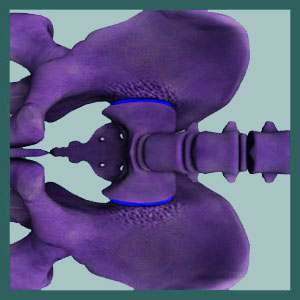
Do you suffer sacroiliac pain lying down? Many people suffer exacerbated symptoms at night when they are desperate for rest. Sleep position is often a major determining factor in symptomatic SIJ activity when patients recline to sleep. So, unlike some forms of activity-related pain, a bit of proactivity might actually generate good results for improved symptomology.
Sleep is one of our primary needs as human beings. We require sleep for a sound mind and body, and people who suffer from chronic sacroiliac pain need their rest more than most. Medical science has proven that chronic pain conditions are literally exhausting. When patients can not sleep, they will suffer exponentially.
This patient guide presents our research and clinical experience dealing with sleep-related sacroiliac joint symptoms. We will examine why some people suffer worsened symptomology at night and how this pain can be minimized in many cases without professional medical intervention.
Symptoms of Sacroiliac Pain Lying Down
Most patients who experience sacroiliac symptoms when lying down also suffer symptoms at other times of the day and during other activities, as well. Most will suffer exacerbated pain when standing and performing particular tasks, although certain diagnoses might make some patients more prone to sitting-related SIJ pain or other activity-enacted discomfort. Only a very small minority of sacroiliac pain conditions will be solely symptomatic due to reclining to rest, although some patients might suffer pain in the joint exclusively when lying down due to some other source process, such as mindbody ischemia.
Statistically, most patients who do experience worsened discomfort when reclining have unilateral pain that has been diagnosed as being caused by sacroiliac joint dysfunction. However, other diagnoses, such as sacroiliitis and various autoimmune diseases in the sacroiliac joint, can also produce reclining-related symptoms in less common scenarios.
Causes of SIJ Symptoms When Lying Down
Anatomical positioning is almost always to blame for pain that is expressed when lying down. Several sleep postures place direct pressure on the sacroiliac joint, from different directions. Depending on the particulars of a patient’s diagnosed condition, certain positions may therefore aggravate or relieve their pain.
Sleeping on the back can produce bilateral pressure on the sacroiliac joints in an anterior direction. This is particularly true for larger sized patients with prominent buttocks. Side sleeping in the fetal position can place direct lateral pressure on the joint unilaterally. The side which suffers is the side facing downwards into the mattress. Meanwhile stomach sleepers can place pressure on the sacroiliac joint in a posterior direction, particularly if they are obese with a larger amount of protruding abdominal fatty tissue.
Coping Strategies for Sacroiliac Pain Lying Down
People can get very ingrained in their sleep habits and changing these preferences might pose problems for patients who are stricken with nighttime sacroiliac pain. However, instead of taking drugs or undergoing some other form of symptom-based care, the ideal therapeutic intervention for sleep-related pain problems is certainly activity modification. Basically, if the patient can change their sleep position, they will generally benefit in terms of pain relief.
If a patient is consistent in their sleep positioning, it is easy to try changes. However, staying put during the hours of sleep might pose problems. Therefore, we recommend using pillows placed at key anatomical locations to prevent turning or moving in one’s sleep. If a patient is not consistent in sleep position, then it might take additional trial and error to discover which position causes pain and which helps ameliorate pain. Having help in this regard is useful and many patients rely on their spouses to help them track which sleep postures are beneficial and detrimental.
Physical therapists can be very helpful in providing guidance on sleep-related pain, but most will basically repeat everything we have already made perfectly clear in this essay. However, if you need additional help getting to the root cause of sleep related structural pain, then asking your physical therapist is the best course of action.
We must mention that many sleep-related pain conditions are psychogenic and not structural, regardless of where in the body they occur or what they are being blamed on. Misdiagnosis of these conditions is an epidemic problem, so patients must be proactive and autonomous in seeking out possible mindbody contributors to pain. We have worked with many patients who suffered terrible nightly pain that seemed to defy logic or treatment. A variety of physical treatments failed, yet the utilization of knowledge therapy got right to the origin of the pain syndrome and defused its symptom-generating imperative for good.
Sacroiliac Joint Pain > Sacroiliac Facts > Sacroiliac Pain Lying Down





